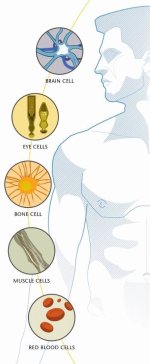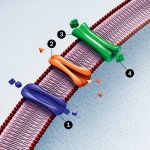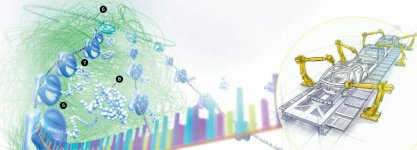Has All Life Descended From a Common Ancestor?
Darwin thought that all life might be traced to a common ancestor. He imagined that the history of life on earth resembled a grand tree. Later, others believed that this “tree of life” started as a single trunk with the first simple cells. New species branched from the trunk and continued to divide into limbs, or families of plants and animals, and then into twigs, all the species within the families of plants and animals alive today. Is that really what happened?
What do many scientists claim? Many give the impression that the fossil record supports the theory of a common origin for life. They also claim that because all living things use similar “computer language,” or DNA, that all life must have evolved from a common ancestor.
What does the Bible say? The Genesis account states that plants, sea creatures, land animals, and birds were created “according to their kinds.” (
You do not have permission to view the full content of this post.
Log in or register now.You do not have permission to view the full content of this post.
Log in or register now.) This description allows for variation within a “kind,” but it implies that there are fixed barriers separating the different kinds. The Bible account of creation also leads us to expect that new types of creatures would appear in the fossil record suddenly and fully formed.
What does the evidence reveal? Does the evidence support the Bible’s description of events, or was Darwin correct? What have discoveries over the past 150 years revealed?
DARWIN’S TREE CHOPPED DOWN
In recent years, scientists have been able to compare the genetic codes of dozens of different single-celled organisms as well as those of plants and animals. They assumed that such comparisons would confirm the branching “tree of life” proposed by Darwin. However, this has not been the case.
What has the research uncovered? In 1999 biologist Malcolm S. Gordon wrote: “Life appears to have had many origins. The base of the universal tree of life appears not to have been a single root.” Is there evidence that all the major branches of life are connected to a single trunk, as Darwin believed? Gordon continues: “The traditional version of the theory of common descent apparently does not apply to kingdoms as presently recognized. It probably does not apply to many, if not all, phyla, and possibly also not to many classes within the phyla.”
You do not have permission to view the full content of this post.
Log in or register now.You do not have permission to view the full content of this post.
Log in or register now.
Recent research continues to contradict Darwin’s theory of common descent. For example, in 2009 an article in
New Scientist magazine quoted evolutionary scientist Eric Bapteste as saying: “We have no evidence at all that the tree of life is a reality.”
You do not have permission to view the full content of this post.
Log in or register now. The same article quotes evolutionary biologist Michael Rose as saying: “The tree of life is being politely buried, we all know that. What’s less accepted is that our whole fundamental view of biology needs to change.”
You do not have permission to view the full content of this post.
Log in or register now.You do not have permission to view the full content of this post.
Log in or register now.
WHAT ABOUT THE FOSSIL RECORD?
Many scientists point to the fossil record as support for the idea that life emerged from a common origin. They argue, for example, that the fossil record documents the notion that fish became amphibians and reptiles became mammals. What, though, does the fossil evidence really show?
“Instead of finding the gradual unfolding of life,” says evolutionary paleontologist David M. Raup, “what geologists of Darwin’s time, and geologists of the present day actually find is a highly uneven or jerky record; that is, species appear in the sequence very suddenly, show little or no change during their existence in the record, then abruptly go out of the record.”
You do not have permission to view the full content of this post.
Log in or register now.
In reality, the vast majority of fossils show stability among types of creatures over extensive amounts of time. The evidence does not show them evolving from one type into another. Unique body plans appear suddenly. New features appear suddenly. For example, bats with sonar and echolocation systems appear with no obvious link to a more primitive ancestor.
In fact, more than half of all the major divisions of animal life seem to have appeared in a relatively short period of time. Because many new and distinct life forms appear so suddenly in the fossil record, paleontologists refer to this period as “the Cambrian explosion.” When was the Cambrian period?
Let us assume that the estimates of researchers are accurate. In that case, the history of the earth could be represented by a time line that stretches the length of a soccer field
(1). At that scale, you would have to walk about seven eighths of the way down the field before you would come to what paleontologists call the Cambrian period
(2). During a small segment of that period, the major divisions of animal life show up in the fossil record. How suddenly do they appear? As you walk down the soccer field, all those different creatures pop up in the space of less than one step!
The relatively sudden appearance of these diverse life forms is causing some evolutionary researchers to question the traditional version of Darwin’s theory. For example, in an interview in 2008, evolutionary biologist Stuart Newman discussed the need for a new theory of evolution that could explain the sudden appearance of novel forms of life. He said: “The Darwinian mechanism that’s used to explain all evolutionary change will be relegated, I believe, to being just one of several mechanisms—maybe not even the most important when it comes to understanding macroevolution, the evolution of major transitions in body type.”
You do not have permission to view the full content of this post.
Log in or register now.
PROBLEMS WITH THE “PROOF”
Why do some textbooks change the scale of the fossils that they depict as following a proposed sequence?
Above left: scale of fossils as shown in some textbooks
Above right: real relative size
What, though, of the fossils that are used to show fish changing into amphibians, and reptiles into mammals? Do they provide solid proof of evolution in action? Upon closer inspection, several problems become obvious.
First, the comparative size of the creatures placed in the reptile-to-mammal sequence is sometimes misrepresented in textbooks. Rather than being similar in size, some creatures in the series are huge, while others are small.
A second, more serious challenge is the lack of proof that those creatures are somehow related. Specimens placed in the series are often separated by what researchers estimate to be millions of years. Regarding the time spans that separate many of these fossils, zoologist Henry Gee says: “The intervals of time that separate the fossils are so huge that we cannot say anything definite about their possible connection through ancestry and descent.”
You do not have permission to view the full content of this post.
Log in or register now.You do not have permission to view the full content of this post.
Log in or register now.
Commenting on the fossils of fish and amphibians, biologist Malcolm S. Gordon states that the fossils found represent only a small, “possibly quite unrepresentative, sample of the biodiversity that existed in these groups at those times.” He further says: “There is no way of knowing to what extent, if at all, those specific organisms were relevant to later developments, or what their relationships might have been to each other.”
You do not have permission to view the full content of this post.
Log in or register now.You do not have permission to view the full content of this post.
Log in or register now.
WHAT DOES THE “FILM” REALLY SHOW?
An article published in
National Geographic in 2004 likened the fossil record to “a film of evolution from which 999 of every 1,000 frames have been lost on the cutting-room floor.”
You do not have permission to view the full content of this post.
Log in or register now. Consider the implications of that illustration.
If “95 frames” of the fossil record show that animals do not evolve from one type into another, why do paleontologists arrange the remaining “5 frames” to imply that they do?
Imagine that you found 100 frames of a feature film that originally had 100,000 frames. How would you determine the plot of the movie? You might have a preconceived idea, but what if only 5 of the 100 frames you found could be organized to support your preferred plot, while the other 95 frames tell a very different story? Would it be reasonable to assert that your preconceived idea of the movie was right because of the five frames? Could it be that you placed the five frames in the order you did because it suited your theory? Would it not be more reasonable to allow the other 95 frames to influence your opinion?
How does that illustration relate to the way evolutionists view the fossil record? For years, researchers did not acknowledge that the vast majority of fossils—the 95 frames of the movie—showed that species change very little over time. Why the silence about such important evidence? Author Richard Morris says: “Apparently paleontologists had adopted the orthodox idea of gradual evolutionary change and had held onto it, even when they discovered evidence to the contrary. They had been trying to interpret fossil evidence in terms of accepted evolutionary ideas.”
You do not have permission to view the full content of this post.
Log in or register now.
“To take a line of fossils and claim that they represent a lineage is not a scientific hypothesis that can be tested, but an assertion that carries the same validity as a bedtime story—amusing, perhaps even instructive, but not scientific.”—
In Search of Deep Time—Beyond the Fossil Record to a New History of Life, by Henry Gee, pp. 116-117
What about evolutionists today? Could it be that they continue to place fossils in a certain order, not because such a sequence is well-supported by the majority of fossil and genetic evidence, but because doing so is in harmony with currently accepted evolutionary ideas?
You do not have permission to view the full content of this post.
Log in or register now.
What do you think? Which conclusion fits the evidence best? Consider the facts we have discussed so far.
- The first life on earth was not “simple.”
- The odds against even the components of a cell arising by chance are astronomical.
- DNA, the “computer program,” or code, that runs the cell, is incredibly complex and gives evidence of a genius that far surpasses any program or information storage system produced by humans.
- Genetic research shows that life did not originate from a single common ancestor. In addition, major groups of animals appear suddenly in the fossil record.
In light of these facts, do you think it is reasonable to conclude that the evidence is in harmony with the Bible’s explanation of the origin of life? Many people, however, assert that science contradicts much of what the Bible says about creation. Is that true? What does the Bible really say?
The biological term phyla (singular, phylum) refers to a large group of animals that have the same distinctive body plan. One way that scientists classify all living things is by a seven-step system in which each step is more specific than the one before it. Step one is kingdom, the broadest category. Then come the categories phylum, class, order, family, genus, and species. For example, the horse is categorized in the following way: kingdom, Animalia; phylum, Chordata; class, Mammalia; order, Perissodactyla; family, Equidae; genus,
Equus; species,
Caballus.
It should be noted that neither the
New Scientist article nor Bapteste nor Rose mean to suggest that the theory of evolution is wrong. Their point, rather, is that Darwin’s proposed tree of life, a mainstay of his theory, is not supported by the evidence. Such scientists still seek other explanations involving evolution.
Henry Gee does not suggest that the theory of evolution is wrong. His comments are made to show the limits of what can be learned from the fossil record.
Malcolm S. Gordon supports the teaching of evolution.
See, for example, the box “
You do not have permission to view the full content of this post.
Log in or register now.”
FACTS AND QUESTIONS
- Fact: Two of evolution’s fundamental ideas—that life has a common origin and that major new body types appear as a result of the slow accumulation of small changes—are being challenged by researchers who do not support the Bible account of creation.
Question: Given the controversy over these pillars of Darwin’s theory, can his version of evolution honestly be referred to as scientific fact?
- Fact: All living organisms share similarly designed DNA, the “computer language,” or code, that governs much of the shape and function of their cell or cells.
Question: Could this similarity exist, not because they had the same ancestor, but because they had the same Designer?
What About Human Evolution?
Look up the topic of human evolution in many textbooks and encyclopedias and you will see a series of pictures—on one side a stooped, apelike creature followed by creatures that have progressively more upright posture and larger heads. At the end stands modern man. Such renderings along with sensational media reports of the discovery of so-called missing links give the impression that there is ample evidence that man evolved from apelike creatures. Are such assertions based on solid evidence? Consider what evolutionary researchers say about the following topics.
You do not have permission to view the full content of this post.
Log in or register now.
WHAT THE FOSSIL EVIDENCE ACTUALLY SHOWS
Fact: At the beginning of the 20th century, all the fossils that were used to support the theory that humans and apes evolved from a common ancestor could fit on a billiard table. Since then, the number of fossils used to support that theory has increased. Now it is claimed that they would fill a railroad boxcar.
You do not have permission to view the full content of this post.
Log in or register now. However, the vast majority of those fossils consist only of single bones and isolated teeth. Complete skulls—let alone complete skeletons—are rare.
You do not have permission to view the full content of this post.
Log in or register now.
Question: Has the increased number of fossils attributed to the human “family tree” settled the question among evolutionary experts as to when and how humans evolved from apelike creatures?
Answer: No. In fact, the opposite is true. When it comes to how these fossils should be classified, Robin Derricourt of the University of New South Wales, Australia, wrote in 2009: “Perhaps the only consensus now is that there is no consensus.”
You do not have permission to view the full content of this post.
Log in or register now. In 2007 the science journal
Nature published an article by the discoverers of another claimed link in the evolutionary tree, saying that nothing is known about when or how the human line actually emerged from that of apes.
You do not have permission to view the full content of this post.
Log in or register now. Gyula Gyenis, a researcher at the Department of Biological Anthropology, Eötvös Loránd University, Hungary, wrote in 2002: “The classification and the evolutionary place of hominid fossils has been under constant debate.”
You do not have permission to view the full content of this post.
Log in or register now. This author also states that the fossil evidence gathered so far brings us no closer to knowing exactly when, where, or how humans evolved from apelike creatures.
You do not have permission to view the full content of this post.
Log in or register now.
ANNOUNCEMENTS OF “MISSING LINKS”
Fact: The media often widely broadcasts the announcement that a new “missing link” has been discovered. For example, in 2009 a fossil dubbed Ida was unveiled with what one journal called “rock-star hype.”
You do not have permission to view the full content of this post.
Log in or register now. Publicity included this headline in
The Guardian newspaper of the United Kingdom (UK): “Fossil Ida: Extraordinary Find Is ‘Missing Link’ in Human Evolution.”
You do not have permission to view the full content of this post.
Log in or register now. However, just days later, the UK science journal
New Scientist said: “Ida is not a ‘missing link’ in human evolution.”
You do not have permission to view the full content of this post.
Log in or register now.
Question: Why is each unveiling of a new “missing link” given wide media attention, whereas the removal of that fossil from the “family tree” is hardly mentioned?
Answer: Regarding those who make these discoveries, Robin Derricourt, quoted earlier, says: “The leader of a research team may need to over-emphasize the uniqueness and drama of a ‘discovery’ in order to attract research funding from outside the conventional academic sources, and they will certainly be encouraged in this by the print and electronic media, looking for a dramatic story.”
You do not have permission to view the full content of this post.
Log in or register now.
TEXTBOOK DRAWINGS AND MODELS OF APE-MEN
Fact: Depictions in textbooks and museums of the so-called ancestors of humans are often shown with specific facial features, skin color, and amount of hair. These depictions usually show the older “ancestors” with monkeylike features and the ones supposedly closer to humans with more humanlike facial features, skin tone, and hair.
Question: Can scientists reliably reconstruct such features based on the fossilized remains that they find?
Answer: No. In 2003, forensics expert Carl N. Stephan, who works at the Department of Anatomical Sciences, The University of Adelaide, Australia, wrote: “The faces of earlier human ancestors cannot be objectively constructed or tested.” He says that attempts to do so based on modern apes “are likely to be heavily biased, grossly inaccurate, and invalid.” His conclusion? “Any facial ‘reconstructions’ of earlier hominids are likely to be misleading.”
You do not have permission to view the full content of this post.
Log in or register now.
DETERMINING INTELLIGENCE BY BRAIN SIZE
Fact: The brain size of a presumed ancestor of humans is one of the main ways by which evolutionists determine how closely or distantly the creature is supposed to be related to humans.
Question: Is brain size a reliable indicator of intelligence?
Answer: No. One group of researchers who used brain size to speculate which extinct creatures were more closely related to man admitted that in doing so they “often feel on shaky ground.”
You do not have permission to view the full content of this post.
Log in or register now. Why? Consider the statement made in 2008 in
Scientific American Mind: “Scientists have failed to find a correlation between absolute or relative brain size and acumen among humans and other animal species. Neither have they been able to discern a parallel between wits and the size or existence of specific regions of the brain, excepting perhaps Broca’s area, which governs speech in people.”
You do not have permission to view the full content of this post.
Log in or register now.
What do you think? Why do scientists line up the fossils used in the “ape-to-man” chain according to brain size when it is known that brain size is not a reliable measure of intelligence? Are they forcing the evidence to fit their theory? And why are researchers constantly debating which fossils should be included in the human “family tree”? Could it be that the fossils they study are just what they appear to be, extinct forms of apes?
What, though, about the humanlike fossils of the so-called Neanderthals, often portrayed as proof that a type of ape-man existed? Researchers are beginning to alter their view of what these actually were. In 2009, Milford H. Wolpoff wrote in the
American Journal of Physical Anthropology that “Neandertals may have been a true human race.”
You do not have permission to view the full content of this post.
Log in or register now.
Honest observers readily recognize that egos, money, and the need for media attention influence the way that “evidence” for human evolution is presented. Are you willing to put your trust in such evidence?
Note: None of the researchers quoted in this box believe in the Bible’s teaching of creation. All accept the teaching of evolution.
The term “hominid” is used to describe what evolutionary researchers feel make up the human family and prehistoric humanlike species.
WHAT IS WRONG WITH THIS PICTURE?
- Such pictures as this are based on the biases and assumptions of researchers and artists, not on facts.You do not have permission to view the full content of this post.
Log in or register now.
The majority of such drawings are based on partial skulls and isolated teeth. Complete skulls, let alone complete skeletons, are rare.- There is no consensus among researchers as to how the fossils of the various creatures should be classified.
Artists cannot reliably reconstruct the facial features, skin tone, and hair of these extinct creatures.- Each creature is placed in its position leading to modern man largely because of the size of its brain case. This is done despite evidence that brain size is not a reliable indicator of intelligence.








